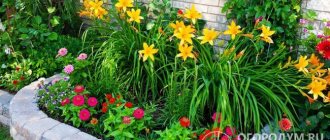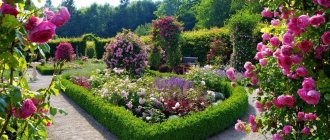One of the most popular types of raw materials for the construction of enclosing structures is hedges. Land owners prefer vegetation due to the fact that in this way the ecological situation in the territory is not disturbed. There is also additional air purification, ionization, and disinfection. The decorative qualities of such a fence are especially enhanced during the flowering period, and many species bear fruit with edible berries.
Low growing shrubs
The low-growing category includes low bushes with shoots up to 1 meter in height. To decorate the garden choose:
- conifers, they are good at any time of the year;
- evergreen with leathery leaves;
- foliage changing color in autumn;
- with edged, red, two-color, carved, palmate, umbrella leaves;
- different flowering periods;
- decorative fruits and berries.
The simplest border of perennial hosta will make any composition in the flowerbed complete
The bushes grow well in open ground and are capable of:
- create compositions yourself;
- serve as a background for other plants;
- form a hedge;
- decorate flower beds and parterre lawns.
The varieties will be discussed further.
Note ! For planting around the perimeter of the site, choose thorny bushes that can be pruned. They are used to form fences that protect against wild animals at any time of the year.
A few notes on care
- Soil preparation. The absence of weeds and soil fertility will ensure good plant development.
- Flowers are chosen depending on the position - for sunny, shaded, dry, humid places.
- Fertilizer and fertilizing. It is necessary to feed plants, especially in poor soils.
- Filling in empty spaces. Curbs with holes in them look unsightly. It is necessary to replant fallen flowers and shrubs in a timely manner.
- Protection of plants sensitive to frost - shelter.
It is difficult to advise the color and character of borders. Some people like “rich” borders with multiple plants, others like uniform outlines. You can create one or more colored borders
It is important that the planting matches the character and style of the garden
Low-growing shrubs for the border: perennial
Flowering shrubs for the garden, perennial and unpretentious
The recommended height of bushes that act as a border is from 25 to 60 cm.
Important! Conifers are not used for border planting in temperate latitudes; they do not tolerate formative pruning.
Among the low-growing shrubs, perennials that grow slowly and are easy to care for are sought for the border.
Note! There are dwarf varieties of species shrubs, their height is from 15 to 40 cm.
When choosing planting material for borders, preference is given to:
- winter-hardy varieties that do not require shelter;
- not demanding on soil composition and acidity;
- growing in shade and partial shade
- resistant to lack of moisture.
Important! Border plants are trimmed regularly to maintain the desired height. When selecting crops, take into account their pliability to mechanical processing.
Low-growing shrubs that do not require regular formative pruning:
- barberry thunberga: a bagatelle variety with purple foliage and a spherical crown. The annual growth of shoots is no more than 2-3 cm; kobol, the leaves change color to yellow or orange in autumn.
- Japanese spirea, Golden Princess variety, forms a compact bush up to 50 cm high.
- Euonymus subspecies Fortune with elongated, pointed leaves with a yellow edge - grows slowly, forms an even spherical bush.
- dwarf caragana grows up to 2.6 meters wide, 30-60 cm high. It retains yellow buds all summer and blooms profusely.
Spiraea grefsheim, planted near the facade, will decorate the house. Characterized by long flowering, grows up to 80 cm tall
Balsam
Impatiens flowers (another name for the plant is “wet vanka”) bloom for a long time, thanks to which you can fully enjoy their beauty. Impatiens can often be found in summer cottages, as they are very easy to care for.
The bush reaches a maximum height of 50 cm, has elongated large fleshy leaves, which over time take on the shape of droplets.
The flowers can be of different colors, although their natural shades are purple and pink. Impatiens bloom begins in May and continues until the onset of frost.
Important! Do not over-feed balsam - excess fertilizer will inhibit the formation of flowers and promote rapid growth of stems and foliage. Impatiens do not require special care, however, when planting, it should be taken into account that the flower is not adapted to low temperatures and strong winds
It is recommended to plant it in places well lit by the sun.
Impatiens do not require special care, however, when planting, it should be taken into account that the flower is not adapted to low temperatures and strong winds. It is recommended to plant it in well-sunny places.
What shrubs are used to make a hedge?
Flowering trees and ornamental shrubs for the garden
Among decorative foliage plants for the garden, crops that form dense crowns are chosen. A hedge should protect from dust, dirt, noise, and prying eyes. Designers distinguish two types of fences:
- unformed, only sanitary pruning is carried out, old, crooked shoots and dry branches are removed;
- decorated, the bushes are given a geometric shape.
Thunberg's barberry lends itself well to pruning; it is used to form columns and even walls
Several fast-growing shrubs used for fences:
- Dogwood grows from 2 to 5 meters, tolerates pruning well, and is shade-tolerant. Growth up to 30 cm per season. Bears fruit, berries are edible;
- the vesicular carp with leaves like viburnum grows up to 4 meters. It blooms in June, the fruits and leaves change color by autumn. Growth 40 cm;
- evergreen thujas with the names Brabant and Smaragd are cold-resistant plants that tolerate frosts down to -15 ° C. Height from 2 to 4 meters. Suitable for wall planting. Growth 30 cm per year;
- juniper is shade-loving; it is planted on the western and northern sides of the site. Cone-shaped varieties are chosen for hedges. Growth up to 25 cm per year, starting from the 3rd year of growth.
Berry plants are used for hedges:
- rose hips acclimatize well in any conditions and are fragrant during the flowering period;
- raspberries, planted in a row up to 60 cm wide, will hide from prying eyes and delight you with the harvest;
- blackberries weave around mesh fences and bear fruit well on the sunny side;
- honeysuckle, grows up to 1.5 meters, bears fruit at the end of June, remains decorative throughout the season, and can be pruned.
Rules of care
In order for a flowering border to delight with lush and regular flowering, it is necessary to provide the plants with proper care and the right conditions. All colors require:
- regular watering procedures;
- timely application of fertilizers;
- treatment against pests and various diseases;
- periodic loosening and mulching of the soil;
- annual pruning, crown formation;
- preparation for the winter period (for young and immature plants).
This is interesting: what are the differences between a curb and a curb.
To save time, you can build a drip irrigation system; moreover, such irrigation allows you to moisten the soil evenly. It is necessary to timely plant a crop that begins to grow, then it will not be able to harm the flowers growing nearby. It is necessary to remove all dry branches and inflorescences, dig up all diseased flowers so that the disease does not spread to other bushes. All this provides the flowers with a beautiful and healthy appearance.
Perennial shrubs blooming for the garden
Decorative shrubs for the garden and cottage
There are many varieties of herbaceous and tree-like shrubs; they are chosen for their resistance to climatic factors. It can be:
- picky roses;
- bulbous and root irises;
- bush Japanese lily, producing yellow gramophones on a long arrow;
- phloxes of different flowering periods, cap shapes;
- paniculate and spherical hydrangeas;
- argyrantemum, growing and caring for it at home does not require much effort.
Note! In risky farming zones, gardeners prefer zoned crops to decorate plots.
Chaenomeles
Japanese quince, or chaenomeles, blooms in early spring. Its orange-yellow, dark red, white or pink petals create an atmosphere of awakening nature in the garden. The bush itself is quite low, sometimes its branches spread along the ground.
Chaenomeles are most often placed in borders. The plant will not create problems for the gardener - it grows quite slowly in size.
Chaenomeles fruits are considered a natural pharmacy due to the large amount of trace elements and vitamins. From a bush you can get up to 6 kg of fruit like an apple. They usually have a golden skin and orange-tinged flesh. The fruits have a subtle lemon aroma, exquisite taste and remain on the branches for more than a month. Japanese quince begins to bear fruit 4 years after planting.
Ornamental shrubs for Siberia
Ornamental shrubs that are suitable for Siberia:
Elderberry Black Beauty is an example of a perennial garden shrub for areas where there are severe winters and recurrent frosts.
- The white dogwood or dogwood of the dogwood family is distinguished by its branching and grows up to 3 meters. Leaves with edges, dark green, dense;
- elderberry is valued for its carved leaves that change color in late autumn and clusters of fruit. Breeders have developed varieties with colored greens;
- spirea in species diversity: pyramid-shaped; in the form of hemispheres; liana-like with spreading long shoots that can rest on support;
- cold-resistant types of barberry: thunberg varieties; Amur; common fruiting; Ottawa.
- Potentilla or Kuril tea is winter-hardy, blooms profusely, the color of the buds is yellow or white.
Important! Young ornamental bushes under the age of 3 years are bent down for the winter so that the branches are under the snow cover. In the spring, sanitary pruning is done on adult bushes and the frozen part of the shoots is removed.
Euonymus Fortune
Recent Entries
Lilac perennials that are beautiful, compact and do not crowd out other plants Why when buying seedlings you should not take the sellers’ word for it and how to determine the age of the plant using 3 signs Tomato seedlings have turned purple or whitish: why the color has changed and how to save the plants
This evergreen creeping shrub provides wide scope for imagination when landscaping the garden. This variety of euonymus is evergreen and is found in natural conditions in China. The height of an adult plant is only 60 cm, but the diameter of the crop can reach three meters.
A distinctive feature of Fortune's euonymus is that its creeping shoots are capable of forming adventitious roots. They attach the plant to the ground and climb up vertical supports. Thanks to this, the shrub can be used not only to create hedges, but also for vertical gardening.
Flowering shrubs for the Urals
They are distinguished by their special variegation and abundant flowering:
- perennial shrub aster;
- varieties of Argyrantemum fruticosa or “Alpine daisies”;
- chrysanthemums or evening primroses from the fireweed family.
In the Ural conditions, most of the perennial shrubs that bloom in summer survive and are used in landscape design for summer cottages and parks. Many spend the winter without shelter.
An example of a mixborder of shrubs and perennials
Schemes of mixborders from shrubs and perennials
When laying out, take into account which side the site is viewed from. There are schemes:
- double-sided, trees, tall bushes are planted in the center, border plantings are made on the sides;
- one-sided, when crops are planted according to height, tall ones as a background for low ones.
When placing perennials, maintain tiers so that the plants do not shade each other. Microsorbers are viewed from a distance; there should be bright color accents. Flowerbeds can have any shape, from round and rectangular to intricately curved.
Important! In the first years, while perennials are growing their crowns, the compositions seem insufficiently dense.
Mahonia
Mahonia is an evergreen shrub that is quite suitable for gardens in the middle zone. The plant is very decorative; its carved bright green foliage becomes brownish-purple with a violet tint in the cold season. Dark blue berries hang in voluminous clusters. By the way, they are edible and have a soft and delicate taste. The fruits are stored for quite a long time.
The root system of Mahonia penetrates into the soil at a sufficient distance to obtain moisture even in extreme conditions. Fertile, slightly acidic soil, always without stagnant groundwater, is most suitable for shrubs. If there is no rain for a long time during the season, the bush must be watered. A bucket of water is poured onto one plant once every two weeks.
Mahonia is planted along paths; Small bushes can be used to delimit the garden area into zones. It will not grow too tall and will successfully serve as a small fence.
Mixborder with hydrangea
The flower does not like bright sun in the afternoon; tall neighbors are selected for it, providing openwork shade. Hydrangea is supplemented with shrubs with decorative foliage: heucheras, hostas, ferns.
Among the flowering crops, lovers of acidic soil choose:
- azaleas;
- bergenia;
- Japanese lilies;
- peonies;
- rhododendrons;
- astilbe.
Large-leaved flower varieties are planted in the center of the composition, with dwarf species at the edges. Among the tall spring flowering shrubs, choose mock orange, weigela, spirea, and barberry.
Paniculata hydrangea looks regal against the background of spruce and pine
Ground cover shrubs
In creeping crops, the roots do not go deep, spread under the surface, and sprout new shoots. A feature of ground cover shrubs is their ability to quickly fill free space. When choosing beautiful unpretentious shrubs, consider:
- demands on soil. The intensity of plant growth depends on the correctly chosen planting site;
- frost resistance. It is not customary to cover borders and areas with stones covered with ground cover crops;
- resistance to diseases and pests;
- flowering time.
Note ! When selecting neighboring plants, take into account the height of the cover being formed.
Ground cover shrubs are coniferous, herbaceous, liana-like, producing shoots up to 5 meters long. Perennials displace weeds from the occupied area and strive to take over new territories. In addition to the aesthetic function, they have a practical function, ridding the soil of contamination. Conifers are compact and grow slowly. Herbaceous ones have good growth and delight with flowers.
For sunny places, all types of fescue are suitable from cereals; from flowering sun-loving perennials, choose:
- alyssum;
- peg;
- blue carnation with an original shade of green;
- catnip, better known as catnip;
- dwarf phlox;
- ground cover asters.
The white cap of Iberis is formed during flowering, the rest of the time the evergreen snowflake pleases with beautiful foliage
Shade-tolerant plants are planted in shaded areas:
- blue periwinkle;
- cuff with decorative leaves in the form of umbrellas;
- creeping tenacious with plumes of inflorescences;
- hostas with colored greens;
- brunner macrofolia;
- white clover, it weaves everything in its path.
Landscape design can turn any area of the garden into a fabulous, unique landscape
There are no specific canons in landscape design; owners of countryside vacation spots decorate the area to their liking. Crops selected for climatic conditions require minimal care. They need to be shaped and periodically fed, then the area will turn into a piece of paradise.
Bloodroot
The charming cinquefoil is ideal for garden design.
The plant blooms throughout the warm season. It is unpretentious and survives even on infertile soil. There are several types of cinquefoil, which can be a ground cover plant or a shrub. The shades of the leaves and their size also depend on the variety. The flowers are white and light orange. They have a tender and fluffy center, golden due to the many stamens.
Cinquefoil is usually not affected by pests. It is ideal for an alpine slide or rock garden. Sunlight will benefit this plant. And being surrounded by stones will make its appearance even more exotic.



